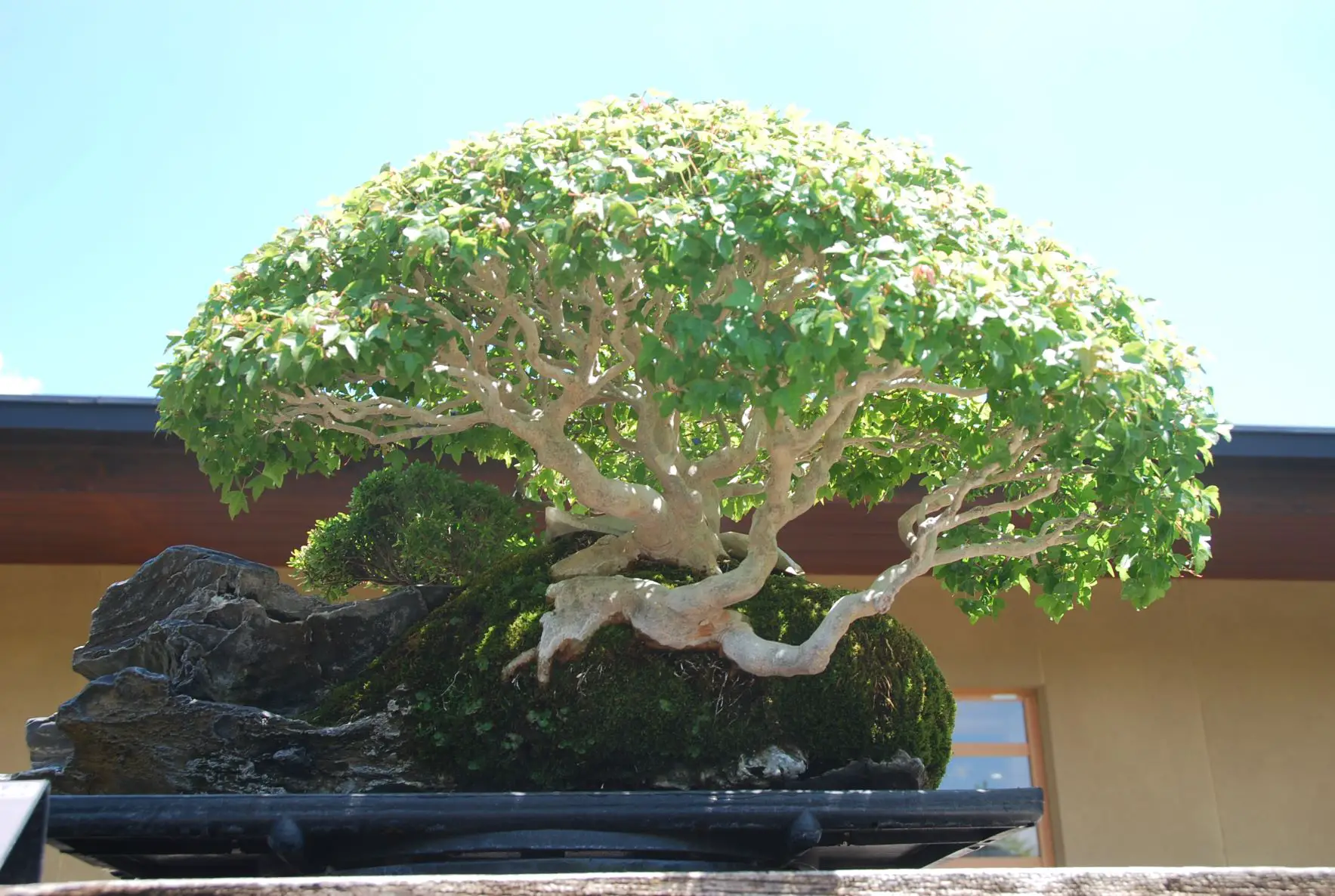There are a few things to look for when choosing a good Japanese maple bonsai.
As a general rule, you should get a Japanese maple tree that is (1) healthy, (2) has certain desirable characteristics as bonsai, and (3) has the potential for good styling to make it a bonsai tree.
If you are wondering which species of a Japanese maple tree to choose, please read this post.
Things to look for when getting a Japanese maple bonsai
There are three things to look for when you are getting a Japanese maple bonsai:
- Tree health
- Characteristics as bonsai and
- Potential for good styling.
Tree health
You can inspect the health of the Japanese maple tree by looking at-
- the crown of the tree
- leaves
- tree bark and
- infestation with insects and diseases.
Crown
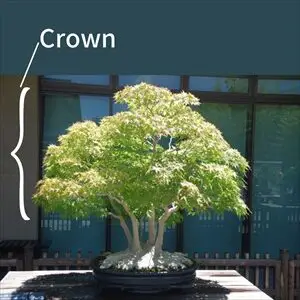
Japanese maple-crown
A well-shaped crown is the first indicator of health and reflects that the tree is growing well. When shaded by other trees, walls/buildings, or placed where there is not enough sunlight, trees will develop one-sided or crooked crowns, which reduces growth. Japanese maple trees tend to grow into umbrella-shaped crowns if they are healthy.
You should also look for the number of branches. Canopies that have very few, thin branches indicate unhealthy growth. A healthy Japanese maple tree tends to have a few very elongated branches as well. This is not good as a bonsai style if they are left to grow, but is a good indicator of vigorous, sound growth.
Leaves
The condition of leaves is the second indicator of tree health.
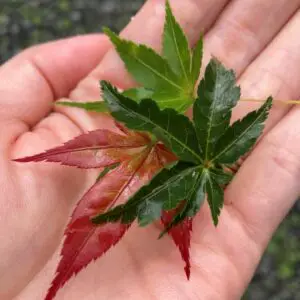
Japanese maple- leaf color
Japanese maple leaves should be dark to light green in color unless they are from a cultivar for ever-red leaves like Nomura. Their shape and size should be uniform and well-formed without strange deformation. Healthy trees have very dense foliage as well.
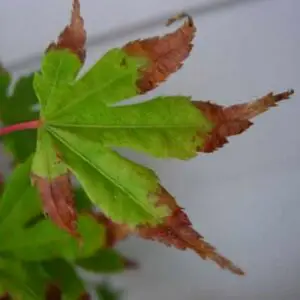
Japanese maple- brown tips
(Souce: University of British Columbia-Link here)
Stresses including the shortage of water causes the tips of the Japanese maple leaves to turn dark or brown. Japanese maples, as tree species, do not have a high tolerance for drought and need constant moisture from spring to fall. Depending on the length of the drought, the tree might not be able to come back to life, or it might be but takes a lot of time to heal.
Bark
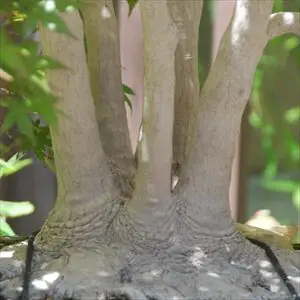
Japanese maple with smooth bark
The bark of the Japanese maple tree should be smooth. A healthy bark is smooth and not loose or peeling. When it suffers from extreme weather (heat/cold) or drought, the tree bark becomes rough and sometimes cracks.
Infestation
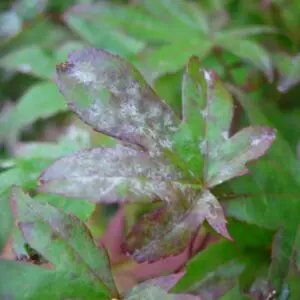
Japanese maple- powerly mildew
(Souce: University of British Columbia-Link here)
Lastly, check if there are no insects or leaves with white, brown, or black spots. White/grayish powdery substances or blackish, brownish spots on leaves, or dying edges are some of the indicators of diseases and you do not want to come back home with sick ones.
Good characteristics as bonsai
Bonsai is the Art of Miniature Landscape: a natural landscape created with plants in a bonsai pot. A tree that lacks certain characteristics does not make a good bonsai even if you try to make (or force) it to be. In order to make a normal Japanese maple tree a “bonsai”, it should have:
- Dense foliage with smaller leaves and attractive leaf color
- Good ramification with a lot of fine branches, and
- Beautiful bark and trunk pattern.
It is true that certain species within the Japanese maple tree family have favorable characteristics genetically but it also depends on the nature of individual trees. Each tree has slightly different characteristics such as leaf color and size, number of branches, and rate of growth. You should be looking for one that has appropriate characteristics as bonsai, that fits your liking as well.
Leaves
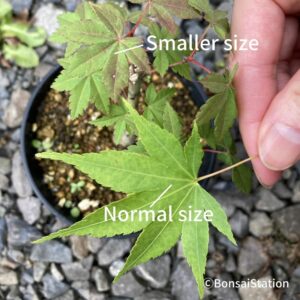
Japanese maple- leaf size
You should be looking for a tree with leaves that are as small as possible. With smaller leaves, a bonsai appears large and fully grown as a tree in nature. The same species of Japanese maple trees can have different sizes of leaves. The leaf color has to be beautiful and attractive as well.
Ramification

Japanese maple-ramification
The next thing you should be looking for as good characteristics of Japanese maple bonsai is a good ramification and a lot of fine branches. Ramification is the finely divided small twigs that make a bonsai look like real trees grown on the ground. Good ramification also pays off in winter when the leaves have fallen and only the trunk and branches are left.
Beautiful bark and trunk pattern

Japanese maple with smooth bark
Lastly, beautiful bark and trunk patterns are desirable. The trunks and branches of the Japanese maple trees are soft and can easily be scratched/wounded. It is best to avoid those with wire scars because these scars on the Japanese maple trees will rarely heal over the years, unlike coniferous trees whose scars gradually heal.
Also, weirdly shaped trees should be avoided. Some bonsai trees in the market are shaped by forcibly wiring branches and trunks. You should keep away from one with any wires that go into the bark. You can further damage the tree by removing wires, in addition to the scars already left there.
Potential for good styling
As for the potential for good styling, the most important part you should be looking into is the base of the tree that goes into the soil and the bottom of the trunk that rises toward the sky. No matter how good the upper part of the tree is, the base of the tree may rarely be altered with styling afterward. The upper shape of the tree may be changed by pruning and wiring if given the time.
Specifically, there are 3 things to look for:
- Surface roots (“nebari”)
- Lowest part of the trunk
- Basis of the shape of the tree
Nebari (surface roots)

Japanese maple- surface roots (“nebari”)
What is “nebari”?
“Nebari” is a Japanese word that describes the roots that appear on the surface of the soil.
In nature, the roots of young trees are hidden in the soil and barely visible. As the trees grow older, the roots become more exposed on the surface of the soil, which look like the legs of an octopus. This nebari or surface roots is a very important bonsai appeal because bonsai aims to show the appearance of old trees.
Why are surface roots important?
Japanese maple trees in nature are known to have good surface roots. A bonsai tree that mimics a tree in nature thus has to have the same feature. You should be looking for surface roots that are exposed evenly spaced on the surface of the soil, entering naturally the soil and support the tree.
It takes years to make good surface roots and once they are formed, it is very difficult to reshape them without risking killing the tree. If you are buying an older tree, avoid one with one or two thick roots growing from one side of the tree. Trees like this not only are hard to train but also become unstable in pots.
Lowest part of the trunk
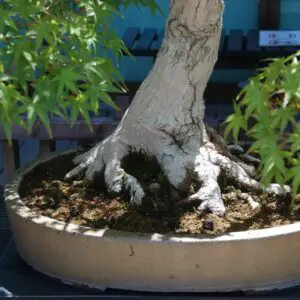
Japanese maple- lowest part (“tachiagari”)
How the lowest part of the trunk to the first branch from the bottom looks is a very important aspect of bonsai appearance for styles such as formal upright, slanting, and two-trunks, whose lower part of the trunk has no branches.
Combined with surface roots, the lowest part of the trunk expresses the stability of the tree, making it appear as if it is grabbing the soil on the ground powerfully as an old tree.
What you should be looking for in the tree, thus, is a straight and round trunk without scars that rises toward the sky from the surface roots, gradually becoming thinner as it goes up.
Shape of the tree

Japanese maple- tree shape
You should be looking for one that has an “interesting-looking” trunk that tapers from base to top. A trunk that just grows straight up lacks character. In styles other than the formal upright, the trunk without some bend is rather unnatural. Look for a trunk that bends slightly to the left or to the right asymmetrically and irregularly.
You might be thinking that you can train the trunk with wiring. But it is difficult to alter the shape of the trunk without damaging the bark because Japanese maple bark is very soft and can easily be damaged without ever healing.
Also, as a general rule, the first branch from the base to the tree should be a third of the height of the tree. Think about how tall you want your Japanese maple bonsai to be and look for one that has branches lower than one-third of the tree’s height. As a plant tends to grow upward, it is very hard to grow a branch naturally toward the bottom of the trunk once it is cut.
—–
Related posts on Japanese maple bonsai
“Why is my Japanese maple bonsai dying?” (Link here)

